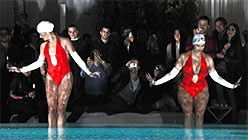Maybe it was the combination of their bazaar-like setup and my own lack of sleep, but the various art fairs during the week of Miami Art Basel kept bringing to mind De Quincey’s “Confessions of an English Opium Eater”. It would not be an exaggeration to trace parallels between the fair-going experience (and the binge tendencies that surface in its subsequent stupor) with the consumption of opiates as described in De Quincey’s decadent ode to the dragon chase.
In Miami, I presented a collaborative performance piece included in William Powhida and Jen Dalton’s project, #rank, which was part of Seven, a new fair located in Miami’s Wynwood district. Powhida and Dalton’s project addressed the hierarchical dynamics that are secluded and included within the art fair dynamic, which made my first-time fair experience even more glaringly absurd. Because I was also helping with Maria Robertson’s performance and because Wynwood was on the other side of town, I wasn’t able to participate more actively and make a careful assessment of the whole project. A hasty one would be that the project felt like an insider’s club, but Mr. Powhida offers a much more considered assessment on his blog, albeit one that is colored by his own opinion.
At Basel, a handful of booths had a lingering effect, mostly because the relationships between the works displayed were carefully considered. Alexander Gray gallery, from New York, had an exhibition that showcased Latin American artists from two different generations: Luis Camnitzer and Paul Ramírez Jonas. Camnitzer’s 194-part artwork, Memorial (2009), replicates the Montevideo, Uruguay, telephone directory, into which he meticulously inserted names of people that disappeared during the military dictatorship between 1973 and 1985. This list-making gesture renders the victims visible again, if only in the public eye, and places the victims side by side with survivors and perpetrators, evening out the roles. In Ramírez Jonas’ sculptural installation Publicar (2010), public monuments usually memorialized with boulders and brass plaques are re-imagined and replaced by cork plaques affixed with pushpins, rendering them as democratic as a community bulletin board. Both artists propose an alternative imagining of possibilities in public artworks.
From Scotland, there was the extremely well-curated booth by The Modern Institute, which made the most of its space by dividing it with strategically placed walls. Featured artists included Simon Sterling, Jim Lambie, and Monika Sosnowska, as well as an impressive mini-solo show by Richard Hughes. Nordenhake, from Berlin, had a solo show by light-guided artist Spencer Finch. The Approach, from London, had a perfect corner in its booth, which combined Patrick Hill‘s two small wall pieces, Lindsey and Dancer (both 2010), with a hanging elastic sculpture by Alice Channer called Le Smoking (2010). Both works offer counterpoints on the nature of dance and movement. I also saw a plethora of George Condo’s work at Basel. That made me very happy, since we most definitely share a common (however distorted) view of the human physiognomy.
The Nada Fair felt more adventurous and pleasurable than Basel due to the sometimes experimental nature of many of the spaces involved. The hallway was definitely one of the fair’s highlights, featuring smaller galleries like 179 canal, which was showing collaborations between Margaret Lee and various artists featured at her former Chinatown space and Dispatch, which displayed artists’ multiples. These booths gave a good idea of what is taking place in artist-run spaces in New York. Rachel Uffner Gallery was another sure stop, where Anya Kielar’s all-white theatrical prop-like paintings contrasted with Pam Lins’ colorful take on compartmentalized sculpture. The Museum 52 booth had in its interior a perfect pairing between colors and shapes with Mariah Robertson’s photos and Sarah Braman’s tilted sculptures. On its outside walls, the booth displayed David Brooks’ works, which playfully contemplated our associations of levity and nature, pairing organic materials with poured cement. White Columns, which offered affordably priced limited editions in its booth, included works by outsider artist Horst Ademeit, including his obsessively annotated Polaroid diary/catalogue, which functions as a tool in his daily fight against the “cold rays” (see link for further information on this phenomena).



